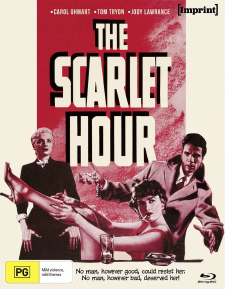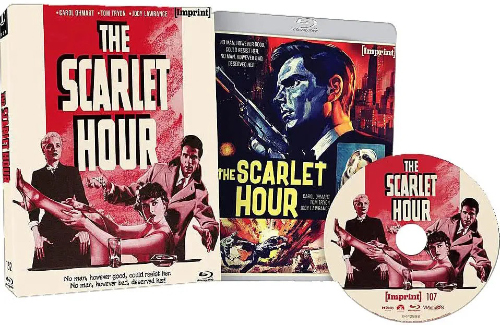Scarlet Hour, The (Blu-ray Review)

Director
Michael CurtizRelease Date(s)
1956 (September 9, 2022)Studio(s)
Paramount Pictures (Imprint/Via Vision)- Film/Program Grade: B-
- Video Grade: A
- Audio Grade: A
- Extras Grade: B+
Review
[Editor’s Note: This is a Region-Free Blu-ray import.]
The Scarlet Hour, sometimes considered the last film noir from the 40s and 50s, has never been afforded the attention it deserves. The fact that it was directed by one of Hollywood’s finest craftsmen, Michael Curtiz, adds to the mystery of why this film is essentially forgotten. With many elements of classic noir, the plot is reminiscent of The Postman Always Rings Twice and Double Indemnity, but The Scarlet Hour lacks the star power of those genuine classics.
Pauline “Paulie” Nevins (Carol Ohmart, House on Haunted Hill) is having an affair with E.V. “Marsh” Marshall (Tom Tryon, The Cardinal). Paulie is married to real estate developer Ralph Nevins (James Gregory), and Marsh is his top salesman. All the lovers need to run away together is money. One night, as they neck secretly in the hills above Los Angeles, they overhear thieves outline their plan to steal valuable jewels from a home when the owners are away. The plan sounds easy and relatively risk-free.
Paulie persuades Marsh that if he hides outside the house, he can rob the robbers, sell the jewels, and he and Paulie can go off to live happily ever after. But, since this is a noir, their plans don’t work out as expected.
Ohmart is the femme fatale who draws her guy into a situation that leads to dark entanglements. Somewhat resembling Barbara Stanwyck but lacking her acting chops, she often seems out of her depth in the more emotional scenes and fails to convey the larcenous streak that’s necessary for the character. Instead, she comes off more as a high-class socialite who’s wandered into the wrong film. Tryon’s Marsh comes off as a decent guy at heart who’s so crazy about Paulie that he agrees to an immoral and illegal plan that could put them both in danger.
Tryon never conveys true passion for Paulie despite their awkwardly staged fondling in a convertible. Ohmart might have come off better with a stronger leading man. Tryon is wishy-washy and never conveys Marsh’s ambivalence when his business relationship with good-hearted secretary Kathy Stevens (Jody Lawrence), a Jan Sterling type, turns romantic. A cliched love triangle develops, though it’s hard to see what these two attractive women see in someone with as much sex appeal as a throw rug.
Because the two leads are rather bland, they never fully engage the viewer. The stand-out performance is by Elaine Stritch, making her screen debut as Paulie’s friend and confidante, Phyllis Rycker. She and Paulie go way back to their lean days as showgirls and we learn a lot about Paulie’s backstory through their exchanges. Stritch dominates every scene she’s in. She delivers a memorable performance in a film in which many of the supporting players are more colorful than the leads.
The film also contains first-rate performances by E.G. Marshall and Edward Binns as detectives, David Lewis as Dr. Lynbury, who has a pronounced interest in the robbery, and Jacques Aubuchon as Fat Boy, one of the jewel thieves. Billy Gray (Father Knows Best) is listed in the credits, and IMDB lists him in the role of Tom Rycker, but his role must have been cut, since he’s nowhere to be seen.
Director Michael Curtiz (Casablanca, White Christmas), who had made stars of Errol Flynn, Doris Day, John Garfield, and others, hoped that The Scarlet Hour would be a good vehicle to propel Ohmart and Tryon to stardom, though he wasn’t happy with Ohmart in such an important role. Paramount had launched an elaborate campaign touting the starlet as the next big thing and wanted the picture to showcase her.
The film contains key ingredients of noir: a male protagonist obsessed with an alluring woman; another woman, good and decent, in love with the man; an urban setting; a lurid plot; shadows, low angles, and unusual photography. Yet The Scarlet Hour, at best, is secondary noir, lacking urgency and underlying tension.
The Scarlet Hour was shot by director of photography Lionel Lindon on black-and-white 35 mm film in VistaVision with Fujinon lenses, finished photochemically, and presented in the aspect ratio of 1.85:1. Imprint’s Blu-ray release is nearly pristine with excellent contrast and deep, rich blacks. Grayscale, too, is excellent. Details, such as individual strands of hair, light facial stubble on the male actors, costume patterns, a bracelet, and water in a swimming pool are nicely delineated. The film has the distinctive noir look with lots of atmospheric shadows, pools of light, half-shadowed faces, and key scenes shot at night. The opening late night scene on a hilltop above Los Angeles with the lights of the city below is evocative of the period. Ohmart’s make-up is intended to give her a veneer of glamour. Jody Lawrence—playing the “good girl”—is more conservative in appearance, and Elaine Stritch, though attractive, wears lighter make-up.
The soundtrack is English 2.0 Mono LPCM. Optional English SDH subtitles are available. Dialogue is clear and distinct throughout. Leith Stevens’ score has a jazz flavor that adds excitement and shores up some sluggish scenes. Nat King Cole’s rendition of Never Let Me Go is quite lovely and its lyrics and melody suggest the attraction between Paulie and Marsh.
Bonus materials include the following:
- Audio Commentary by Alan K. Rode
- Theatrical Trailer (1:55)
In the commentary by Film Noir Foundation board member Alan K. Rode, he notes that The Scarlet Hour was made from an original screenplay and features a “top-notch cast of actors.” The film was shot on a 30-day schedule on a a modest budget of $1,130,000. Michael Curtiz had just directed a box office dud, The Vagabond King, and The Scarlet Hour was meant to give a late boost to his career. As the film unreels, several of the Los Angeles area locations shown in the film are identified. Brief overviews of the cast are included. Nat King Cole, who appears only in one scene to sing Never Let Me Go, was paid $10,000, the same salary Carol Ohmart received as the star of the picture. Working titles were Too Late My Love and The Kiss Off. Paramount had promoted Ohmart as its newest star and, in a 1989 interview, she said that working for Curtiz was a nightmare. He was brusque with her and berated her in front of the crew, in keeping with his reputation as a bully director. During his career, Curtiz directed 181 films and was especially prolific during his long Warner Bros. tenure. The Scarlet Hour was offered to but turned down by Barbara Stanwyck. Ohmart experienced the last stages of the studio star system. After appearing in House on Haunted Hill, she did other low-budget films and made guest appearances on TV shows, became hooked on drugs, was badly beaten in a street crime, and eventually changed her name and left Hollywood. Many other actors who had appeared in films of the 1940s and 50s became household names and were seen by millions on TV. Examples include Lloyd Bridges (Sea Hunt), Broderick Crawford (Highway Patrol) and E.G. Marshall (The Defenders).
The Scarlet Hour is interesting as a Michael Curtiz film, a showcase for Carol Ohmart, and the screen debut of Elaine Stritch. As film noir, it contains many of the tropes of the genre but is derivative of other, better films.
- Dennis Seuling


